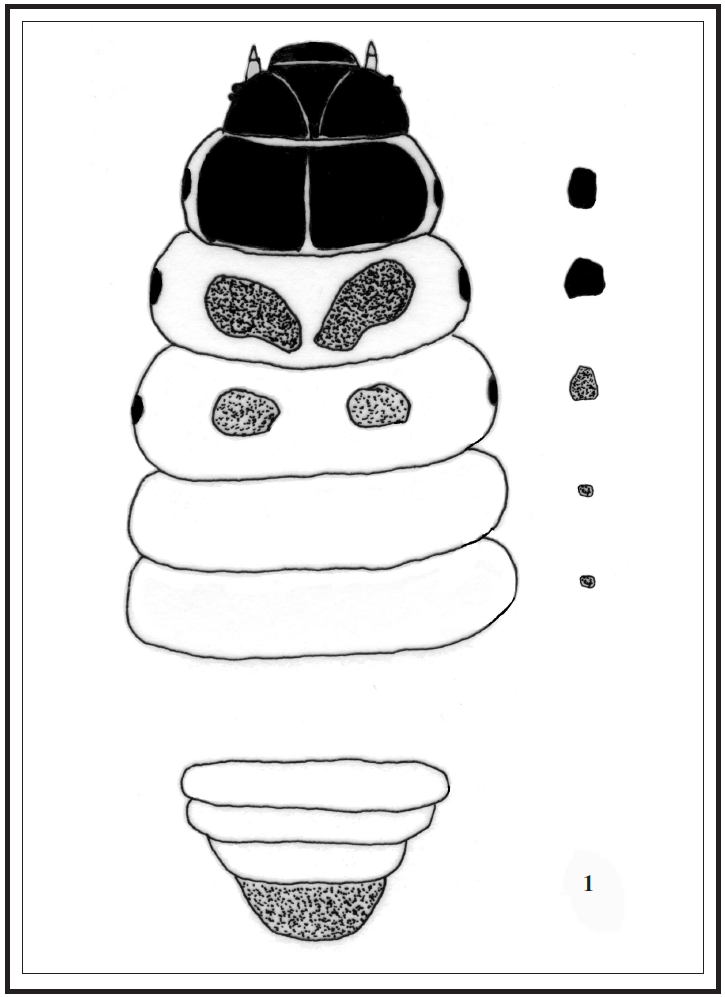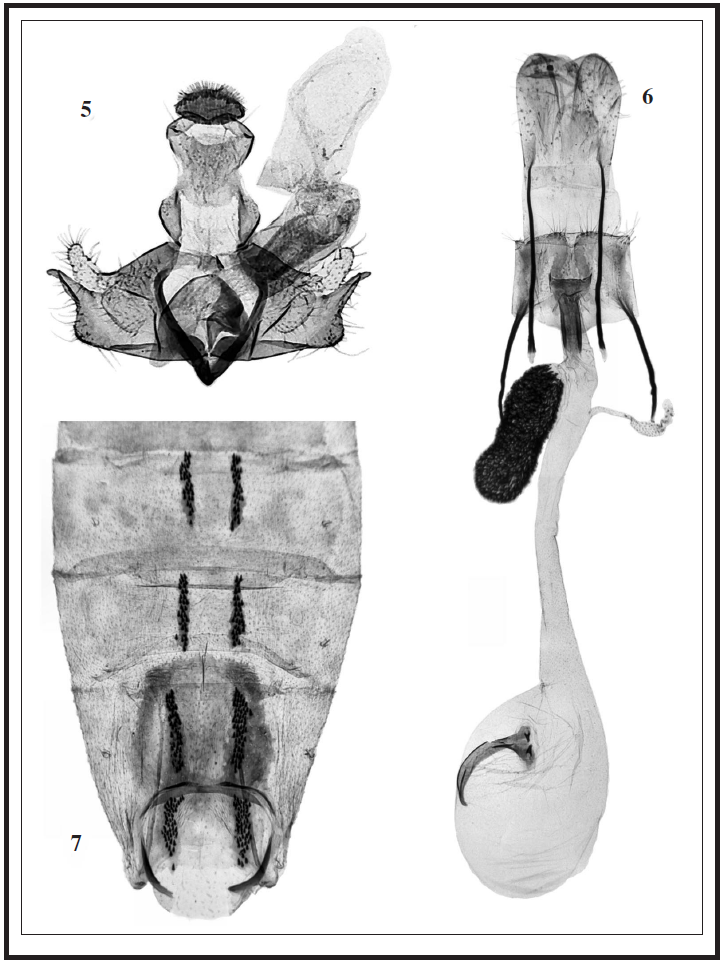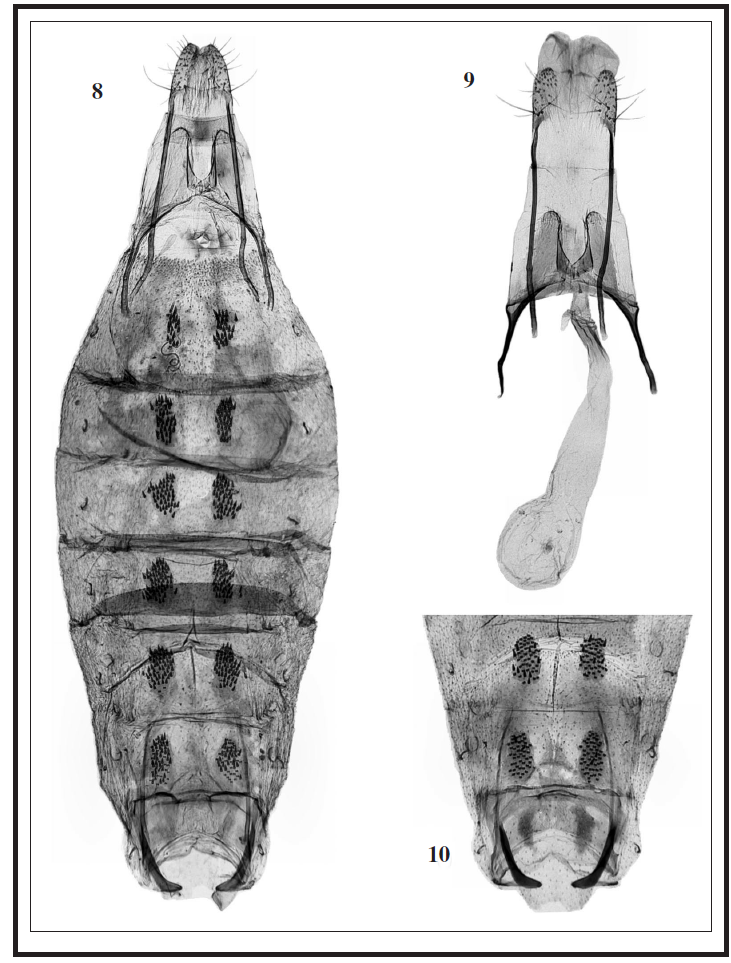

On the identity of Coleophora perplexella Toll, 1960 and C. murciana Toll, 1960. Contributions to the knowledge of Coleophoridae. CXXXIII (Lepidoptera: Coleophoridae)
Sobre la identidad de Coleophora perplexella Toll, 1960 y C. murciana Toll, 1960. Contribución al conocimiento de los Coleophoridae. CXXXIII (Lepidoptera: Coleophoridae)
On the identity of Coleophora perplexella Toll, 1960 and C. murciana Toll, 1960. Contributions to the knowledge of Coleophoridae. CXXXIII (Lepidoptera: Coleophoridae)
SHILAP Revista de lepidopterología, vol. 44, núm. 173, 2016
Sociedad Hispano-Luso-Americana de Lepidopterología
Recepción: 27 Julio 2015
Aprobación: 20 Agosto 2015
Abstract: The aim of this work is to clarify the synonymy between Coleophora perplexella Toll, 1960 and C. murciana Toll, 1960, syn. n.. Based on study of the typical materials and recently collected specimens, it is shown that the original type series of C. murciana was composed of two species, the male holotype being conspecific with C. perplexella and the female allotype with C. hiberica Baldizzone, 1985. In this work C. perplexella Toll, 1960, is redescribed, and the larva L5 is described for the first time.
Keywords: Lepidoptera, Coleophoridae, Coleophora perplexella, Coleophora murciana, new synonymy, larva.
Resumen: El objetivo de este trabajo es clarificar la sinonimia entre Coleophora perplexella Toll, 1960 y C. murciana Toll, 1960, syn. n.. Basado en el estudio del material tipo y la reciente captura de nuevos especímenes, se demuestra que la serie tipo original de C. murciana estaba compuesta de dos especies el holotipo macho era coespecífico con C. perplexella y el alotipo hembra con C. hiberica Baldizzone, 1985. En este trabajo se redescribe C. perplexella Toll, 1960 y se describe por primera vez la larva L5.
Palabras clave: Lepidoptera, Coleophoridae, Coleophora perplexella, Coleophora murciana, nueva sinonimia, larva.
Introduction
Coleophora perplexella Toll, 1960 and C. murciana Toll, 1960 were described by Sergiusz Toll in the same publication, on page 252 and 253 respectively, from specimens collected in southern Spain (TOLL, 1960). The description of the first species was based on a single female from Chiclana, and until recently only the genitalia of the holotype were known. For the second species TOLL (1960) illustrated the genitalia of both sexes after a series of males from various localities in southern Spain and a single female from Murcia, all without collecting date.
The habitus and structural features (wing pattern, abdomen, and genitalia) of both taxa were later published in the author’s posthumous volume on the Palaearctic Coleophoridae (TOLL, 1961). In the last few years I had the chance to study several specimens of Coleophora which I have partly attributed to C. perplexella, and partly to C. murciana.
Under C. perplexella I illustrated and described the male genitalia, and showed a picture of the female genitalia, demonstrating that Toll’s original drawing was inaccurate: the spiny appendage of the ductus bursae was incorrectly drawn because Toll did not remove the genitalia from the abdomen (BALDIZZONE, 1986). As a matter of fact, I had studied the genitalia preparation of the holotype of C. perplexella, by courtesy of J. Razowski, and noted that it would have been impossible to verify the correct structure of the ductus bursae without dismantling, repairing and reassembling the old preparation, a rather challenging task.
NEL (2001) illustrated the male genitalia of a Coleophora as that of C.murciana and, subsequently, recorded the discovery of C. perplexella from France, illustrating also its female genitalia and larval case (TAUTEL & NEL, 2009). The following year NEL (2011) announced the discovery of the host plants of C. perplexella and provided information on its bionomics.
The assessment of the bionomics and the study of several specimens from Spain and Southern France prompted me to re-examine several male genitalia preparations without being able to spot any reliable differences between those which were ascribed to C. murciana and those I had attributed to C. perplexella on the basis of specimens collected by E. Traugott-Olsen near Marbella (Spain). Moreover, a pair of C. perplexella reared by NEL (2010) gave the impression that C. perplexella and C. murciana were the same species.
The main diagnostic features remained therefore those in the female genitalia, which seemed to be very different between the two species as a consequence of the illustration that TOLL (1960, 1961) gave of those of C. murciana and C. perplexella, the former being totally devoid of spines on the ductus bursae and of signum on the corpus bursae.
In the past, I had the chance to study and photograph the genitalia preparation of the female allotypus of C. murciana from Murcia by courtesy of H. J. Hannemann (slide 443 Toll, in Zoologisches Museum der Humboldt-Universität, Berlin). As in Toll’s case, the genitalia were left in the abdomen, and were subsequently stained with Chlorazol Black by B. W. Rasmussen in order to obtain a coloration more suitable for photography.
After careful examination of this preparation one can clearly note that the strengthening structure of the abdomen (fig. 8) shows oval tergal discs (3rd tergite) which are only twice as long as wide and thus do not correspond to thos of male murciana, where it shows a thin and elongate shape, the discs being at least 5 times longer than wide.
After looking at the structure of the genitalia (fig. 8) I realized that TOLL (1960) described his C. murciana based on specimens of two different species: the male specimens perfectly match females of C. perplexella collected or reared in later years; whilst the female allotypus of C. murciana corresponds to the species that I had subsequently described as C. hiberica Baldizzone, 1985.
On the basis of the aforementioned reasoning the following new synonymy is thence proposed.
Coleophora perplexella Toll, 1960 (figs. 2, 3) Acta zool. Cracov., 5(7): 252. Holotypus 0: “Chiclana, 17-VII”; “PG |Gr. v. Toll No. 1674 0”; coll. Polish Academy of Sciences, Institute of Systematics and Evolution of Animals, Kraków, Poland. = Coleophora murciana Toll, 1960, Acta zool. Cracov., 5(7): 253, syn. n. Holotypus 1 : “Murcia”;“Präparat |No 440/ Gr. v. Toll”;“Coleophora/ murciana Toll | Gr. v. Toll det.”; “Holotypus”; “Museum für/ Naturkunde | Berlin | Altbestand”, coll. Zoologisches Museum der Humboldt- Universität Berlin, Germany.

Redescription
Wingspan 12-14 mm. Male (fig. 2). Head yellowish white, dorsally with ochreous tinge. Antenna with white scape, ventrally ochre-coloured, and flagellum ringed with white and pale brown. Labial palpus dorsally and internally whitish, ochreous on external side; second segment with thick tuft of dark apical scales reaching upper part of third segment, which is half as long as the second. Thorax pale ochreous. Forewing yellow, more or less darkened, with thin white line along costa and over costal fringes; thin white lines are also more or less distinctly visible along wing fold and on wing cell; fringes pale pearl grey. Hindwing brown or light grey-brown, with fringes similar to those of forewing. Abdomen light brown.

Female (fig. 3). As in male except for more elongated and slightly falcate forewing tip, with larger and more marked costal line, particularly at tip, and middle streak usually larger and more distinct.
Male genitalia (fig. 5): Knob of gnathos large and oval. Tegumen thickset, constricted at middle, its short peduncles with slightly broadened external margin. Transtilla short and straight. Valvula with round ventral margin. Cucullus short and oblique, slightly narrower at tip. Sacculus with rounded ventral corner, dorsal corner with a triangular protuberance which does not reach tip of cucullus. Phallotheca short, cone-shaped, and weakly sclerotized.

Female genitalia (fig. 6): Papillae anales large, oval in outline and elongated. Apophysis posterior about twice as long as anterior. Sclerotization of the trapezoidal sterigma more evident along the distal and lateral margins, and also along a band which encircles the ostium bursae, this latter being cup-shaped and at the centre of the sterigma. Colliculum elongated and narrow, with lateral margins strengthened. Ductus bursae membranous, widest posteriorly, narrowest at middle, then dilated at junction with bursa; its posterior region with lateral bag-shaped elongated appendix richly provided with spines.
Abdominal apodemes (fig. 7): Postero-lateral bars absent, transversal bar slightly convex with the central area of the proximal margin. Tergal discs (3rd tergite) 5 times longer than wide, and with 20-25 short conical spines.

Larva (L5 stadium) (fig. 1): Length 6-7 mm. Head very dark brown, almost black, trunk chlorophyll green. Thoracic and stigmatic plates brown, their pigmentation weaker expressed from anterior to posterior ones. Prothoracic shield large, heavily sclerotised, blackish-brown and with narrow perpendicular groove; mesothoracic shield consisting of paired large sclerites less sclerotized than prothoracic shield, irregular and oval in shape, drawing closer distally; metathoracic shield with paired sclerites smaller than previous ones, oval and well separated. Spiracular sclerites brown, darkest on T1-T2, of irregular trapezoid shape, that on T2 being the largest. Legs with dark-brown sclerites, darkest externally. Prolegs on A3–A6 with a double row of 4 to 6 crochets. Anal shield brown. Anal proleg formed by two crescents, bearing compact series of 16 to 18 crochets. [Description based on a larva collected by J. Nel in France, Var, île de Gaou, on March 2010].
Larval case (fig. 4): Elongated cylindrical, ca. 8 mm long, entirely made of silk appearing creased; anterior part dark-brown, becoming lighter towards the posterior end, anal opening trilobate. Oral opening angled 30 with respect to longitudinal axis. Note: the cases studied by NEL (2010) correspond well to one found attached to a support in Algarve (Portugal) by M. Corley (pers. comm.), except for the angle of oral opening being set at 45º.
Bionomics
The bionomics was partially described by NEL (2010), who studied the species in southern France. Eggs are probably directly deposited on leaves of Hordeum murinum L. and Bromus sterilis L. (Poaceae). The young larvae mine the leaves, hibernate and re-start feeding in the following spring, producing distinctive white mines which are 1.5 mm long and 2-3 mm wide. Pupation takes place inside the case attached to a support. Adults are on the wing usually between end-March to mid-May, occasionally until July. In Sardinia the species was collected in May.
Distribution: Portugal, Spain, southern France, Sardinia, Algeria, Morocco (BALDIZZONE et al., 2006).
Agradecimientos
I would like to thank all of those who have contributed with material and information to the writing of this note, in particular Jacques Nel (La Ciotat, Francia) who has also donated a larva which I have drawn and described, Thierry Varenne (Nice, France) who provided photos of the larva, and Gianni Allegro (CRA-PLF Research Unit for Intensive Wood Production, Casale Monferrato, Italy), who took pictures of the adults. I’m grateful to Wolfram Mey (Zoologisches Museum der Humboldt- Universität Berlin, Germany) for all the information he provided. Particular thanks also go to my friend Josef Razowski (Kraków, Poland), who for many years has supplied specimens from the Toll collection for study. Gratitude is also due to Alessandro Giusti (Natural History Museum, London, Great Britain) who translated this note into English, Alberto Zilli (Natural History Museum, London, Great Britain) and Javier Conde (Madrid, Spain) who revised the English translation and supplied useful suggestions for the manuscript. I’d also like to thank Antonio Vives (Madrid Spain) for the translation of the abstract in Spanish.
BIBLIOGRAPHY
BALDIZZONE, G., 1985.– Contribution à la connaissance des Coleophoridae, XLII. Sur quelques Coleophoridae d’Espagne (Première partie: Description de nouvelles espèces).– Nota lepidopterologica., 8(3): 203-241.
BALDIZZONE, G., 1986.– Contributions à la connaissance des Coleophoridae. XLII. Sur quelques Coleophoridae d’Espagne (Seconde partie: Espèces nouvelles pour la Faune espagnole, ou peu connues).– Nota lepidopterologica, 9: 2-34.
BALDIZZONE, G., van der WOLF, H. & LANDRY, J., 2006.– Coleophoridae, Coleophorinae (Lepidoptera).– In World Catalogue of Insects, 8: 1-215.
NEL, J., 2010.– Sur la biologie de Coleophora perplexella Toll, 1960, dans le Var (Lep. Coleophoridae).– Oreina, 11: 4.
TAUTEL, C. & NEL, J., 2009.– Coleophora perplexella Toll, 1960, un nouveu coléophore pour la France observé dans le Var (Lep. Coleophoridae).– Oreina, 7: 15-16.
TOLL, S., 1960.– Studien über die Genitalien einiger Coleophoridae XVI. (Lepidoptera)-. Acta Zoologica Cracoviensia, 5: 249-309.
TOLL, S., 1962.– Materialien zur Kenntnis der paläarktischen Arten der Familie Coleophoridae (Lepidoptera).– Acta Zoologica Cracoviensia, 7: 577-720 + 133 pls.
Notas de autor